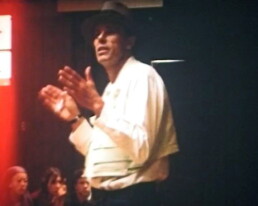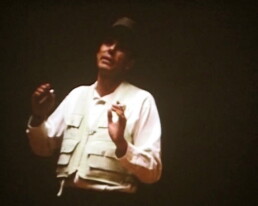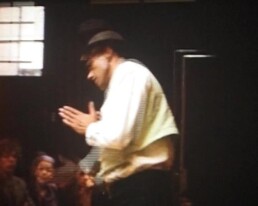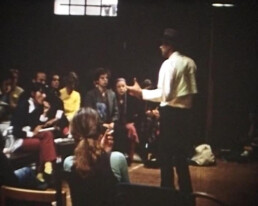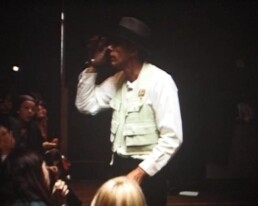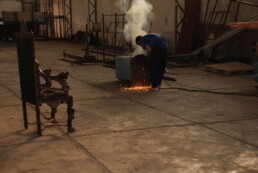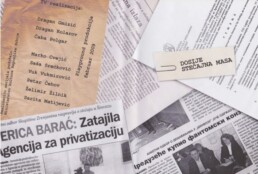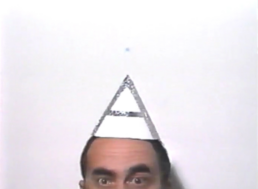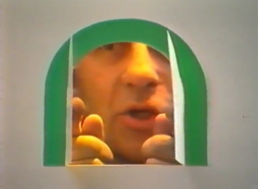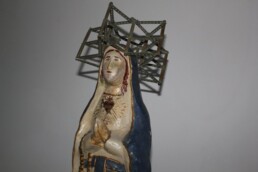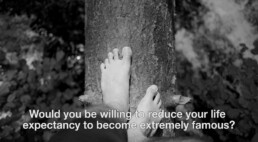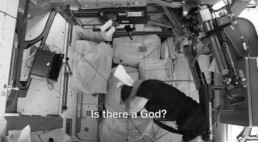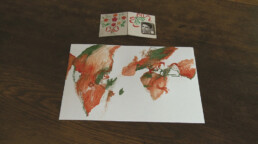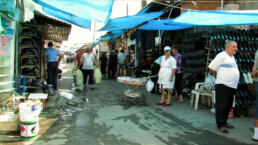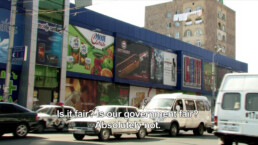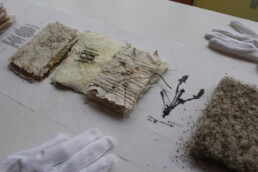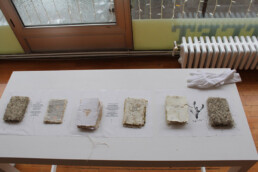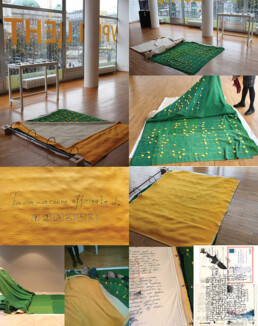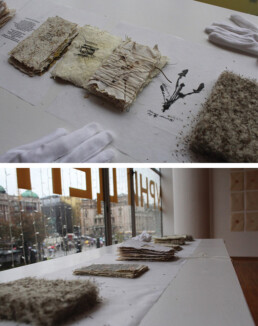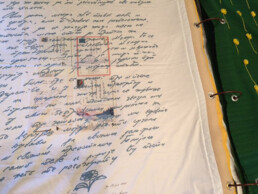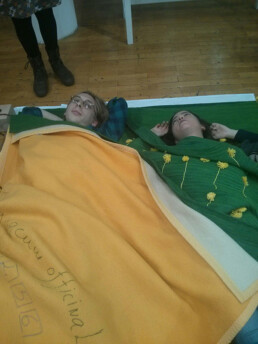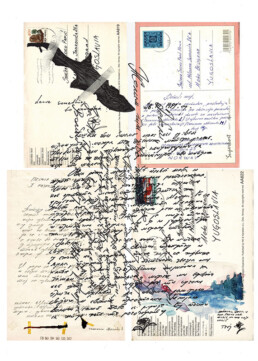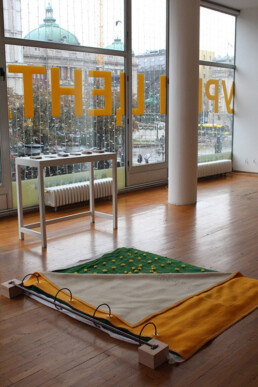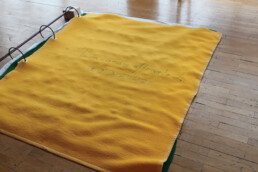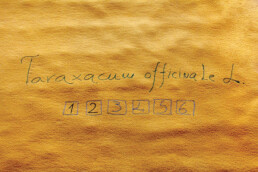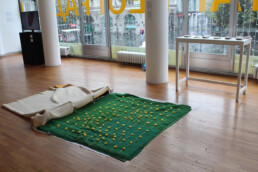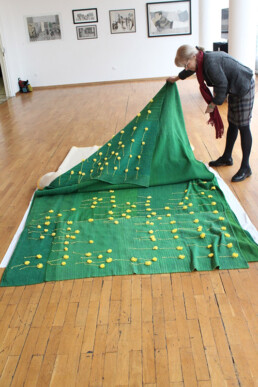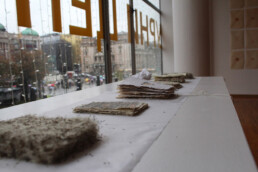Zoran Popović
ZORAN POPOVIĆ (1944)
Gestural Speech of Joseph Beuys
8mm film, regular, colour, 18fps digitally remastered
15’ 55”
edition 2/5 (5+2AP)
1973/2016
Gestural Speech of Joseph Beuys
8mm film, regular, colour, 18fps digitally remastered
15’ 55”
edition 2/5 (5+2AP)
1973/2016
The film was edited in 1973, when it was also shown in Student Cultural Centre; it was shown several more times during the 1970s, after which the author forgets about the film, the ways of art leading him elsewhere.
However, editor at the “Menjačnica (Exchange Office)” Gallery of the Goethe Institute started a programme of exhibitions in 2016 (which has continuously been going on to date, for full five years), with the idea of presenting the work of the artists who in any way collaborated with German artists or created work that in any way interacts with German arts and culture. I remembered then that I had at a certain point recorded a not inconsiderable series of black-and-white photos and colour slides, as well as the mentioned film. For this occasion, I accepted the job and digitally postproduced this film. I re-edited it, added several frame sequences, and recorded instrumentals for musical background, which was Richard Wagner’s. This digital version of the film was made in 2016 from the material recorded in 1973.
The premiere of the digital version of the film was in the Goethe Institute on 3 March 2016, as part of the exhibition Document as a Work of Art: Gestural Speech of Joseph Beuys, Film and Photography by Zoran Popović, 1973 (Edinburgh Art Festival). “Menjačnica” Gallery of the Goethe Institute in Belgrade.
Zoran Popović, artist
In the “Menjačnica” Gallery of the Goethe Institute, the artist exclusively presented the film and photographs made in 1973, when he recorded the twelve-hour lecture of the world-renowned German artist Joseph Beuys at Edinburgh Art Festival, where he himself had an exhibition. At Edinburgh Art Festival in 1973, in the Eight Yugoslav Artists exhibition organised in the Richard Demarco Gallery, Popović presented his graphics and slide projections of his two performances, previously put on in Belgrade (the Axioms performance, put on in the Student Cultural Centre gallery in September 1972, and the photo performance Hiding behind Sally Holman, made in Tašmajdan park in June 1973).
At the mentioned festival, as part of the Richard Demarco Gallery’s programme, which was presented on 19 August 1973 in the Melville College theatre, Marina Abramović, Gergelj Urkom, Raša Todosijević, and Zoran Popović each presented their performances on the same stage at the same time.
In the same location, on 20 August 1973, Popović used an 18mm camera to record Joseph Beuys’s performance: Twelve Hour Lecture: A Homage to Anacharsis Cloots (Anachrasis Cloots, Prussian nobleman, born in the vicinity of the German town Kleve, was an important figure in the French Revolution and a member of the French Parliament from 1792 to 1794). Popović’s fifteen-minute film focuses on the bodily and gestural speech of Joseph Beuys. Popović complemented the film with music, which additionally emphasises the aesthetic and reduces the pragmatic interest in Beuys’s action, and also establishes the difference between fomal transfer of contents and bodily shape of communication. Beuys’s lecture and Popović’s film are two extremes that operate effectively as a whole.
Apart from this film, the Goethe Institute Gallery also exhibited some 30 photos, colour and black-and-white, of smaller and larger formats, whose content corresponds to the film, while the photos are additionally interesting as a document because the faces in the audience are those of the Belgrade art scene of the time: Biljana Tomić’s, Raša Todosijević’s, Gera Urkom’s, Neša Paripović’s, Marina Abramović’s, Jasna Tijardović’s, Nuša’s and Srečo Dragan’s, Irina Subotić’s, Žika’s and Sanja Gligorijević’s, Tom Marioni’s (an artist, writer, and curator who founded the Museum of Conceptual Art in San Francisco in 1970).
In addition to the obvious documentary quality, this work dedicated to Beuys also has a way of pointing out different affinities of Popović’s narratives, from the biographical to the analytical and theoretical ones, and indirectly relating the times, manners, influences, and exchanges within the art practice of the period.
Una Popović
© Cultural Centre of Belgrade, the October Salon Collection and the artist
Purchase agreement: III-5-300/22.10.2021.
Inventory No. 1708
Photo: video frame, courtesy of the artist
ABOUT THE AUTHOR:
Zoran Popović (1944, Belgrade, Serbia) has been present on the Serbian and former Yugoslav scene for more than forty years, and his role has also been rather prominent in relevant international art events (to which the artist’s detailed biography and bibliography testify). The following general information from his rich artistic biography should particularly be emphasised. He was a member of the historic group of six artists who in the early 1970s brought the ideas and actions of the so-called new art practice to Belgrade, effecting one of the greatest transformations in understanding the language of art and the means of artistic expression. In this context, Popović is the author of a series of seminal pioneer works, such as the first artist film – the 1968 Head/Circle, as well as a whole system of drawings, photographs, posters, installations, and performances, titled Axioms (1971-1973).
During his stay in New York, in 1974 he made personal and professional contact with core representatives of the American conceptual art; he took part in the happenings they organised and collaborated with The Fox journal (1975). His stay in New York is documented by the socially-engaged auteur film Struggle in New York (1976), which is an anthological piece of conceptual art in Serbia and worldwide. He participated in numerous presentations of contemporary Yugoslav art abroad (Edinburgh, Vienna, Warsaw, Modena, Dortmund, Berlin, Brussels, Luxembourg, Rome, Genoa, etc.) as well as in the 1977 Paris Youth Biennale. His work was featured in the retrospective exhibition New Art in Serbia from 1970 to 1980, organised by the Museum of Contemporary Art in 1983, the same year in which he also staged a solo exhibition titled New Iconoduly in the Salon of the Museum of Contemporary Art, which opened a new stage and initiated a whole series of ideas and achievements that has to date been growing and developing. He deals with theoretical work and exhibition organisation; he is active in the cultural and artistic life of his community. He took part in the highly significant international exhibition in Bonn in 1994, during which the suggestion was made that, after the fall of the Berlin Wall, East-European and West-European art scenes should be merged (Europa – Europa Das Jahrhunderet Der Avantgarde In Mitel und OstEuropa/Europe – Europe, One Hundred Years of Avant-Garde in Central and Eastern Europe), and his work was also featured in René Block’s 2003 exhibition In den Schluchten des Balkan, in the Fridericianum in Kassel. His contributions and papers dealing with his work can be found in numerous publications in the country and abroad, among which the most significant include Theories and Documents of Contemporary Art (Berkeley: University of California Press, 1996) and Art and Social Change: A Critical Reader – Anthology (Tate Publishing with Afterall, London, 2007), which contain his text “For Self-Management Art.” The second edition of this book, published in Portuguese and English in Sao Paolo, was intended for Brasil and Latin America. He is the winner of several coveted awards, including the “Sedam sekretara SKOJ-a” (“Seven Secretaries of the Union of Communist Youth of Yugoslavia”), which was of great importance in the Yugoslav context (Zagreb, 1973); 31st October Salon award for drawing (Belgrade, 1990); the Branko Vučićević Award (Belgrade, 2019). He is a member of the Association of Fine Artists of Serbia.
(The author’s narrative biography written by Jerko Ješa Denegri)
Želimir Žilnik
ŽELIMIR ŽILNIK (1942)
The Bankruptcy Estate Dossier
digitally remastered TV series
3 x 30 min
edition 1/3
2008 – 2018
The Bankruptcy Estate Dossier
digitally remastered TV series
3 x 30 min
edition 1/3
2008 – 2018
Part of the work was exhibited at the 50th October Salon Circumstance in 2009.
With this documentary series, the Playground production completes the story of a failed privatisation of two companies from Zrenjanin: using ŠINVOZ and BEKO as examples, it actualises the attitude of society as a whole towards the processes of economic transformation and opens a public dispute on the social consequences of this transformation.
Combining documentary recordings of labour strike, video archives, and statements from experts in different social studies such as economics (economists and economic media analysts) or workers’ rights (trade union representatives, legal experts, labour psychologists) as well as from the representatives of state bodies and institutions competent for the privatisation process, crime and corruption fight, social dialogue initiation – we try to reach the answer to the question: Why the position and rights of workers are seldom talked about?
Realisation and research team:
Dragan Gmizić, Dragan Kolarov, Csaba Polgár, Vuk Vukmirović, Saša Srećković
Director: Želimir Žilnik
Producer: Sarita Matijević
© Belgrade Cultural Centre, the October Salon Collection, and the artist
Purchase agreement: III-5-291/18.10.2021.
Inventory number: 1706
Photo: video frame, courtesy of the artist
Selected bibliography:
50th October Salon, Circumstance. Belgrade Cultural Centre, 2009.
ABOUT THE AUTHOR:
Želimir Žilnik (1942, Niš, Yugoslavia) is an artist-filmmaker from Novi Sad, Serbia. In his highly prolific career, Žilnik has made over 50 feature and short films, which have been exhibited internationally at film festivals including Berlin, Toronto, Rotterdam, Moscow and Oberhausen. From the late 60s, his socially engaged films in former Yugoslavia earned him accolades, but also censorship in the 70s and the 90s for his unflinching criticism of the government apparatus. His power to observe and unleash compelling narratives out of the lives of ordinary people is the common thread throughout his work.
Recently, Žilnik has been the subject of major career retrospectives at Kunsthalle Wien, 2020/21; Centre Pompidou, Paris, 2019; Cinemateca Argentina, 2018; Mar del Plata Int. Film Festival, 2017; Anthology Film Archive, New York & Harvard Film Archive, 2017 etc.
His work has been featured in programs of art galleries, museums and art institutes around the world (Documenta, Kassel, Germany; Venice Biennale, Italy; ICA London, UK; National Gallery of Art, Washington DC, USA; MUMOK, Vienna, Austria; MACBA, Spain; Museo Universitario Arte Contemporaneo, Mexico City, Mexico, etc.).
www.zilnikzelimir.net
Vladan Radovanović
VLADAN RADOVANOVIĆ (1932)
Around
book-sheet music, colour photographs; video
30 х 21 cm, 20 pages; 4′
1984-2021
Around
book-sheet music, colour photographs; video
30 х 21 cm, 20 pages; 4′
1984-2021
Around is a vocovisual work recorded as a video in 1984. Centro Videoarte from Ferrara had commissioned this work with the purpose of participating in the Immagine e suono Festival in Ferrara, in February 1984.
The whole work “revolves” around the English word around. The number of segments of the work corresponds to the number of letters/sounds of the word. Each segment deals vocally and visually with each letter and sound of the word. For the purpose of creating the work, the artist manufactured all the props from cardboard and personally performed all the movements and sounds that were planned. Each segment brings a variation to the interpretations of the letter that is “revolving.” The last letter, “d,” is placed in front of a mirror, whereby the letter “g” is formed above “d,” which the voice actualises as “god.” Vladan Radovanović had suggested the vocovisual as a multi-media genre of art, which in addition to the sound, visual, and spatial elements can also include the kinetic and tactile, always with the corresponding meaning. The work encompasses all the sound and visual phenomena, movements, and poetics, from glossolalia and rhopalic verse, through carmina figurate, to concrete, kinetic, visual, and sound “poetry.”
© Belgrade Cultural Centre, the October Salon Collection, and the artist
Purchase agreement: III-5-299/22.10.2021.
Inventory number: 1709
Photo: video frame, courtesy of the artist
ABOUT THE AUTHOR:
Vladan Radovanović (1932, Belgrade, Serbia) graduated in Composition from the Belgrade Music Academy, under the mentorship of professor Milenko Živković. With three other artists he founded Mediala in 1958 and left it in 1959. He initiated the foundation of the Electronic Studio at Radio Belgrade, which he managed from 1972 to 1999. In 1993, he proposed a project and founded the SINTUM open group. In 2000, he proposed the establishment of the Multimedia Art programme at postgraduate interdisciplinary studies of the University of Arts in Belgrade.
He does research and creative work in 10 fields. Since 1953, he has been recording and drawing dreams. Since 1954, he has been involved in character-meaning-sound, later vocovisual and proto-conceptual projectism. In 1955, he introduced the concept of action (similar to the later concept of performances). That same year, he also introduced minimalism or reductionism into music, and between 1958 and 1959 he developed cosmically sacral hyper-polyphony. Since 1956 he has been conducting research in tactilism. Since 1957, he has been developing the polymedium (later renamed into synaesthetic art), ideograms, and body work (similar to later body art). Since 1958 he has nurtured semi-abstract structuralism in visual arts.
As regards the purely technological development, he has been making tape music since 1960, pure electronic music since 1966, computer music since 1977, and computer graphics since 1988.
AVI MOGRABI
AVI MOGRABI (1956)
Z32
35 mm colour film
81’
2008
Z32
35 mm colour film
81’
2008
The film Z32 is a story of a young man, a former member of the elite unit of the Israeli Defence Forces, who recounts and reconstructs a murderous operation to his girlfriend and the viewers. The young man, as an anonymous confessor, reveals a contradiction between the adrenaline experiences at the battlefield, as a soldier would recount it, and the need for forgiveness, felt by a civilian. One of the questions the director asks is whether a film or cinema can become the hiding place for a war criminal. Mograbi’s remarkable film – a “documentary musical-tragedy”, as he himself describes it, takes us through a labyrinth which consists of a sense of duty to the homeland, an admission of guilt, a plea for forgiveness and the military reality, which is rarely a subject of discussion.
© Cultural Centre of Belgrade, the October Salon Collection and the artist
Gift Contract:
Inventory No. 207
Photograph: still from the film
ABOUT THE AUTHOR:
Avi Mograbi (1956, Tel Aviv, Israel) lives and works in Tel Aviv. He studied art and photography, and gained his first production experiences working as an assistant director on numerous commercials and feature films. His own filmmaking career began in 1989. Since 1999, he has taught documentary and experimental film at Tel Aviv University and the Bezazel Academy of Art and Design in Jerusalem.
He is equally committed to social, cultural and political justice in the Middle East and to the experimental and innovative approach to cinematic language. He is actively involved in Breaking the Silence, an organization dedicated to collecting the testimonies of Israeli soldiers who served in the occupied Palestinian territories. His films have been screened at numerous film festivals around the world, including Cannes, Berlin, Venice, Rome, New York, Marseille, San Francisco, Prague, Krakow, Sao Paulo, Rotterdam, Bilbao, Taiwan, Split…
More about the work at www.avimograbi.org
DRAGAN SRDIĆ
DRAGAN SRDIĆ (1958)
Sweet Ideologies 2
mixed media, plaster, iron, glass
100 х 50 cm (changeable)
2018
Sweet Ideologies 2
mixed media, plaster, iron, glass
100 х 50 cm (changeable)
2018
The central place of the installation is occupied by Virgin Mary – Madonna, an authentic Catholic statue of the Virgin. The very year in which the sculpture was made, 1941, corresponds to the beginning of People’s Liberation War and the socialist Revolution as an attempt at establishing a new ideology whose leading symbol was a five-pointed star. A large number of five-pointed stars is lined in preserve jars. In these jars, they look agreeable, edible, benign. The way in which the new regime, under this symbol and following the victorious Revolution, imposed the new ideology was certainly not sweet, edible, and agreeable. Reshaping the man alone, the believer, an individual person, was not enough; the stamp of the new authorities also had to be imprinted on one of the basic symbols of religion – Virgin Mary. Hence her head is surrounded by a five-pointed-star-shaped halo.
The misfortune of this part of the world is that exclusivity is part of every system. Perhaps the time has come to stand up in defence of the five-pointed star.
Dragan Srdić
© Cultural Centre of Belgrade, the October Salon Collection and the artist
Purchase Contract: III-5-282/08.10.2021.
Inventory No.
Photograph:
ABOUT THE AUTHOR:
Dragan Srdić (1958, Belgrade, Serbia) graduated from the Faculty of Philosophy, Art History Department. Since the 1980s he has been exhibiting at various group exhibitions (1989 XV Rijeka Biennale of Young Artists; 1996 A View of the Wall in Rex Centre, Belgrade; 2001 Dossier Serbia in Vienna, Berlin, Belgrade; 41st Belgrade October Salon in 2000; 42nd Belgrade October Salon in 2001; 45th Belgrade October Salon in 2004; 2010 Spring Exhibition of the Association of Fine Artists of Serbia in Belgrade) as well as solo exhibitions (1988 The Last Supper in the Gallery of Students’ Cultural Centre in Belgrade; 1993 Early Works in the Gallery of Students’ Cultural Centre in Belgrade; 1995 Guernica in the Gallery of Students’ Cultural Centre in Belgrade; 1998 VPI in Belgrade Youth Centre; 2000 Anatomy Class in the Fine Arts Gallery of Belgrade’s Cultural Centre; 2005 Metropolis in Belgrade’s Zvono Gallery; Josip Broz Tito 1980-2008 in Belgrade’s Remont Gallery; 2016 Short Cuts in Belgrade’s Ozon Gallery; 2019 Wailing Wall / More than surrealism, more than zenitism in Belgrade’s Grad Cultural Centre).
VALERIO BERRUTI
VALERIO BERRUTI (1977)
The Girl and the Tree
mixed media
92 cm x 71 cm
2008
The Girl and the Tree
mixed media
92 cm x 71 cm
2008
In Valerio Berruti’s works – drawings, sculptures and installations – children’s figures are represented in a simplified manner and evoke a nostalgic feeling of peace but also some awkward uncertainties that childhood, from an adult perspective, brings. Berruti’s figures of children are not determined in terms of time or space; they give the artist the freedom to “play” with primordial themes and philosophical questions.
Beruti’s work reveals his interest in childhood as an art object and his preoccupation with the simplicity of lines. He represents the collective imagination where these children become metaphors in which everyone can recognize themselves. The child depicted by the artist’s perfected and seemingly “hard” lines leads us to more complex structures of meaning, associations and feelings. Beruti’s lines convey purity, innocence, fragility, vulnerability and nostalgia.
© Cultural Centre of Belgrade, the October Salon Collection and the artist
Purchase Contract: Legal basis: purchase from the City of Belgrade Competition, the Mayor’s Conclusion No. 6-1382/09-G – 12.9.2009.
Inventory No. 212
Photo:
Selected Bibliography:
48th October Salon, Micro-Narratives. Cultural Centre of Belgrade, 2007
Valerio Berruti: Suviše je svetla da ne bismo verovali u svetlo, catalogue of the solo exhibition, text by Zorana Đaković Minniti, Cultural Centre of Belgrade, 2011
ABOUT THE AUTHOR:
Valerio Berruti (1977, Alba, Piedmont, Italy) graduated in art criticism from DAMS in Turin. His works have been presented at many important exhibitions and are part of museum collections, including the National Museum of 21st Century Art MAXXI; in 2009 he was the youngest artist at the 53rd Venice Biennale; participated in the Japanese Kizuna Project – one of the most significant humanitarian projects that helped the reconstruction of Japan after the earthquake in 2012; won the international Luci d’Artista Award, etc. He lives and works in Verduno, near Cuneo, in a deconsecrated 17th-century church, which he bought and restored in 1995.
More information at www.valerioberruti.com
SINIŠA RADULOVIĆ
SINIŠA RADULOVIĆ (1983)
77 Questions
HD video
7’
2015
77 Questions
HD video
7’
2015
The work was exhibited at the 56th October Salon, The Pleasure of Love.
The concept of the work 77 Questions is to introduce the viewer to the state of an existential observation of reality and the emotions that shape it, through the simple method of questions and answers.
Gradually creating a high emotional charge, the work reconsiders the position and ethics of artist in today’s society, but also the position of man in general in relation to the infrastructure thus created.
As the basis of the structure, the video uses found footage, public domain, audio generators, polygraph interrogation methods and similar artificial elements. The combination of these elements creates an atmosphere of deep isolation and discomfort, with the aim to ask questions about the hypocrisy, narcissism and a lack of emotion in the world (of art), defined by competitiveness and by capitalism.
© Cultural Centre of Belgrade, the October Salon Collection and the artist
Purchase Contract: III-5-455/14.11.2018.
Inventory No. 1623
Photo: still from the video work
ABOUT THE AUTHOR:
Siniša Radulović (1983, Podgorica, Montenegro) graduated and obtained his master’s degree in painting from the Faculty of Fine Arts in Cetinje. He has participated in numerous group exhibitions in Montenegro, Serbia, Bosnia and Herzegovina, Germany, Albania, Switzerland, Spain, the Netherlands, Macedonia, Italy, Russia and Bulgaria. He won the Award for Painting at the 33rd Montenegrin Art Salon and the Award for Video Art at the 38th Montenegrin Art Salon. In 2017 he won Milčik – awarded to the best young visual artists in Montenegro. More information at www.sinisa.me
SINIŠA ILIĆ
SINIŠA ILIĆ (1977)
Without a Proposition for a Concrete Solution
HD video, sound, drawing – pencil on paper
25’, 500 cm x 120 sm
2016
Without a Proposition for a Concrete Solution
HD video, sound, drawing – pencil on paper
25’, 500 cm x 120 sm
2016
“By creating a unique space of ambient installation, the author draws the viewer into the game of memory and attitude towards memory without a proposition for a concrete solution for the viewer, but strongly brings them into the game of memory and ‘working’ with memory. The work also deals with the idea of friendship, which is not only private, and behind whose narrative lies all the heaviness of historical relations that network individual destinies, and thus shape or break down relations of friendship and love”
From the citation of the 56th October Salon Jury
The work was awarded at the 56th October Salon in 2016.
It was exhibited in Paris (Kadist Foundation), Ljubljana (Museum of Contemporary Art, Metelkova), Zagreb (Vladimir Nazor Gallery), Belgrade (56th October Salon and March Short and Experimental Film Festival).
The work Without a Proposition for a Concrete Solution, structured as a spatial installation and video, considers the concepts of friendship and solidarity in three chapters. I am taking the context of the Non-Aligned Movement and the complex political landscapes of the second half of the 20th century as a historical prism that refracts these topics. The starting point of the entire work is a hand-painted postcard from my private archive, dating back to the 1970s, written in broken Serbo-Croatian. The postcard was sent to my father as a gesture of friendship by an Egyptian friend/colleague. In the first chapter, the object and its written message bring us back to the time of non-aligned politics and the relations that the movement promoted and created. The concept of the world as an image of the political map, often found in the politics of the Non-Aligned Movement, is being established and deconstructed before the viewer throughout the work. The second chapter consists of conversation notes with a woman friend. Running through the content of the conversation – that is not heard but is present in the form of telops that enter the film’s structure – are toponyms such as Amsterdam and Sweden, topics of classes and immigration, as well as the organization of life in the capitalist system. This conversation, located in an apartment somewhere in Western Europe, reconstructs the potentials of freedom in the past, at the same time predicting a society that balances on the thin line between communion and situations of control and micro-violence.
The last chapter of the video is a metaphorical and alienated image of the mechanism of mass production of images, representing conflicts and pressures as social matrices in whose cracks we must find the space for encounter.
The spatial installation shapes the way we observe the film and other elements in the space. It is an inharmonious ambience of questionable functionality – it is a simulation of a museum and a fictionalized historical cabinet at the same time. It is a space in which the ideas and narratives of the work are unstable; they are floating, open for interpretation, looking for fragile connections and relations that open up a space for sharing of time, knowledge and emotions.
© Cultural Centre of Belgrade, the October Salon Collection and the artist
Purchase Contract: III-5-472/16.12.2019.
Inventory No. 1668
Photo: still from the video work, installation view 56th October Salon, Boris Burić
ABOUT THE AUTHOR:
Siniša Ilić (1977, Belgrade, Serbia) is a visual artist who uses various media to deal with social phenomena and mechanisms, exploring forms of labour, tensions in society, violence and states of uncertainty. A co-founder of TkH – Walking Theory (2001–2017), art and theory platform in Belgrade; he has exhibited in the country and abroad: in Belgrade – at the Museum of Contemporary Art, Cultural Centre of Belgrade and October Salon; in Zagreb – Nova Gallery, Vladimir Nazor Gallery and HDLU; in Paris – the Georges Pompidou Centre, Kadist Foundation; in London – Tate Modern and Calvert 22; then at the Ural Biennial in Yekaterinburg and WUK and Open Space in Vienna. He explores the forms of collective work and deals with scenography and stage and performance design. He graduated and obtained a master’s degree from the Faculty of Fine Arts in Belgrade. A co-curator of the national exhibition of the Prague Quadrennial of Performance Design and Space, 2019. More information at http://sinisailic.blogspot.com
OLIVER RESSLER
OLIVER RESSLER (1970)
Socialism Failed, Capitalism is Bankrupt. What Comes Next?
video
19’
edition: 1/5 + 1 a.c.
2010
Socialism Failed, Capitalism is Bankrupt. What Comes Next?
video
19’
edition: 1/5 + 1 a.c.
2010
In the video work Socialism Failed, Capitalism is Bankrupt. What Comes Next? Ressler focuses on the political and economic situation in the Republic of Armenia, one of the successor states of the Soviet Union. The film was recorded in the summer of 2010, at the largest bazaar in Yerevan, called Bangladesh.
Every day, more than a thousand people try to survive by working as salesmen at the Bangladesh Bazaar in Yerevan, where they do not earn more than 100 to 250 Euro a month. In the video, they talk about how they survived the crisis in the post-socialist state, which closed most Soviet-era factories and destroyed social safety nets. Former factory workers describe the changes in living conditions that occurred after the collapse of the Soviet Union, talk about their hopes and expectations for social change. While they live in misery, a small but very influential class of corrupt politicians and extremely wealthy oligarchs is teaming up with international corporations to further enrich themselves with profits from the transfer of state property and mining licenses.
A former mathematics professor Levon Yeremyan, who now works at Bangladesh Bazaar, notes, “95 per cent of people work and get the minimum wage, which is ridiculously low by European standards, and 5 per cent live like Arab sheikhs. Most people would definitely agree with his description of the wide gap between the impoverished masses and the oligarchs in Armenia. This deep divide contradicts the official flattering data.
Concept, camera, sound recording, video editing and production: Oliver Ressler
Interviews, translation and editing assistance: Arpineh Galfayan
Audio mix and colour correction: Rudi Gottsberger
Research on factories: Nora Galfayan, Vahe Budumyan
The project was done during a residency in Yerevan in the framework of the project “Eat and Work”, directed by Anna Barseghian, supported by Utopiana and BM:UKK
© Cultural Centre of Belgrade, the October Salon Collection and the artist
Gift Contract: III-5-82/3.3.2020.
Inventory No.
Photo: still from the video work
Selected Bibliography:
Oliver Ressler: Cartographies of Protest, Juan Antonio Álvarez Reyes, Marius Babias, Emanuele Guidi, Stella Rollig (Eds.), Verlag für Moderne Kunst, Vienna, 2014
http://www.ressler.at/socialism_failed/
ABOUT THE AUTHOR:
Oliver Ressler (1970, Knittelfeld, Austria) is an artist and filmmaker. His installations, interventions in the public space and films raise issues such as economics, democracy, global warming, forms of resistance and alternative lifestyle. He has had solo exhibitions at the Berkeley Museum, Museum of Contemporary Art in Belgrade, Conde Duque Cultural Centre in Madrid, Forum for Contemporary Art in Alexandria, the Cube Space in Taipei, the Wyspa Art Institute in Gdansk, Lentos Museum in Linz, Centre for Contemporary Art in Seville, Salad Galata in Istanbul, National Museum in Bucharest, etc. He has participated in over 350 group exhibitions around the world and his thirty films have been screened at numerous events, art institutions and festivals. A retrospective of his works was organized at the Centre for Contemporary Art in Geneva in 2013. Lives and works in Vienna. More information at http://www.ressler.at/biography
NENA SKOKO
NENA SKOKO (1960)
“FAIRY-TALE ABOUT MIHAILO” CYCLE
- Taraxacum officinale L “1,2,3,4,5,6”
BOOK-BED (Love)
mixed media
190 x 150 x 20 cm
edition: single copy
1998/2016/2017
- “Young Man and Dandelion Flower”
BOOKS-MINIATURES (Young Man and Dandelion Flower, or The End that Was Not)
mixed media
six mini books, dimensions for each 10 x 7 cm
edition: single copy
1998/2016/2017
“FAIRY-TALE ABOUT MIHAILO” CYCLE
- Taraxacum officinale L “1,2,3,4,5,6”
BOOK-BED (Love)
mixed media
190 x 150 x 20 cm
edition: single copy
1998/2016/2017
- “Young Man and Dandelion Flower”
BOOKS-MINIATURES (Young Man and Dandelion Flower, or The End that Was Not)
mixed media
six mini books, dimensions for each 10 x 7 cm
edition: single copy
1998/2016/2017
The work was exhibited at the 56th October Salon, The Pleasure of Love, in 2016.
FAIRY-TALE ABOUT MIHAILO
Once upon a time there were a Young Man and a Dandelion Flower.
They were sincerely and deeply in love with each other.
They thought the greatest misfortune and obstacle to their love was their not being of the same kind.
Both at a certain point wished to be like the other.
By some incomprehensible magic their wishes came true.
The Dandelion Flower became a young woman,
and the Young Man became a dandelion.
Regardless of everything, the sun was still shining,
and winds kept blowing.
Nena Skoko Snežana
The greatest love stories are tragic… This work transcends touch – from the metaphor of the love bed, through walking a tightrope that forms a connection, to the touch that disappears like dandelion seed. These books can be leafed through, touched by hand, as well as by the whole body. Complete surrender in impossible circumstances turns lovers into clowns or tragic characters, and these two opposites are represented through the oxymoron of the most direct corporeality and delicately confined spirituality.
Ivana Podnar
Fairy-Tale about Mihailo
The topic I deal with is LOVE, my love story, partly real, mysterious, irrational, possible and impossible fairy-tale with a lesson. The topic is considered through five segments, five books which deal with the encounter, the kiss, love, parting, and the end respectively. Two of the books are presented here:
BOOK-BED (Love)
The yellow blanket with which I covered myself is also the cover of this book. Book pages are made of five blankets, which I wove and decorated with pom-poms, while the sixth page is a bed cover with Mihailo’s love letter printed on it. Counting from one to six was an expression of love for Mihailo and me.
BOOKS-MINIATURES (Young Man and Dandelion Flower, or The End that Was Not)
The leaves of mini books are made of parachuting dandelion seed and easy to tear apart and destroy. The impossibility of love and the end of Mihailo’s life made my love story develop towards a not merely unlovely ending, but also a tragically unhappy one. Common dandelion (Taraxacum officinale) is genus of weed. I don’t know if it can be uprooted.
Nena Skoko Snežana, excerpts from the 56th October Salon catalogue
© Cultural Centre of Belgrade, October Salon Collection and the artist
Purchase Contract: III-5-280/08.10.2021.
Inventory No.
Photo: 56th October Salon exhibition, courtesy of the artist
Selected Bibliography:
56th October Salon, The Pleasure of Love. Belgrade Cultural Centre, 2016.
ABOUT THE AUTHOR:
Nena Skoko Snežana (1960, Zemun, Serbia) completed her BA and MA studies at the Faculty of Applied Arts in Belgrade, Department of Textile Design. She received further education from professor Kirsti Rantanen at the University of Industrial Arts in Helsinki, during the student exchange programme organised by the Yugoslav and Finnish Ministries of Culture in 1989; at the Academy of Fine Arts in Poznan, where she studied under the mentorship of Magdalena Abakanowicz and Anna Goebel, with the scholarship from the Polish Ministry of Culture (1991-1993); at Goldsmiths in London, in 1994, where as a visiting graduate she worked with professor Janis Jefferies; in New York, where in 1999 she participated in the CEC ArtsLink residency programme’s workshop for papermaking by hand, Dieu Donne Papermill. She founded and led the LOOM art workshop (Lavatorium of Artistic Thoughts, 1995-1998), dedicated to research and education in the field of visual arts. She founded the independent art association Punctum for Art Experiment in 2000, gathering a large number of associates – artists from the country and abroad. Since 1989, she has been participating in exhibitions and organising numerous workshops, presentations, and lectures in the country (Belgrade, Zrenjanin, Kragujevac, Gornji Milanovac, Kruševac, Novi Sad, Banja Koviljača, Vranje, Bogovađa, Sjenica, Subotica, Niš, Raška, etc.) and abroad (Bosnia and Herzegovina, Slovenia, Macedonia, Poland, Lithuania, Estonia, the Netherlands, Italy, Morocco, Russia, England, Denmark, USA, Finland, etc.). She is a member of ULUPUDS (The Applied Artists and Designers Association of Serbia) since 1985 and ULUS (Association of Fine Artists of Serbia) since 1999. She has been a freelance artist since 1992. She received the distinguished artist recognition in 2005. Nena Skoko Snežana’s works are collected in the Museum of Applied Arts in Belgrade, Telenor Company, Imago Mundi Luciano Benneton Collection (Serbia Reconsidered, Contemporary Artists from Serbia), Atelier 61 in Novi Sad, and the Museum of Jean-Lurçat and Contemporary Tapestry in Angers, France (Musée Jean-Lurçat et de la tapisserie contemporaine).
